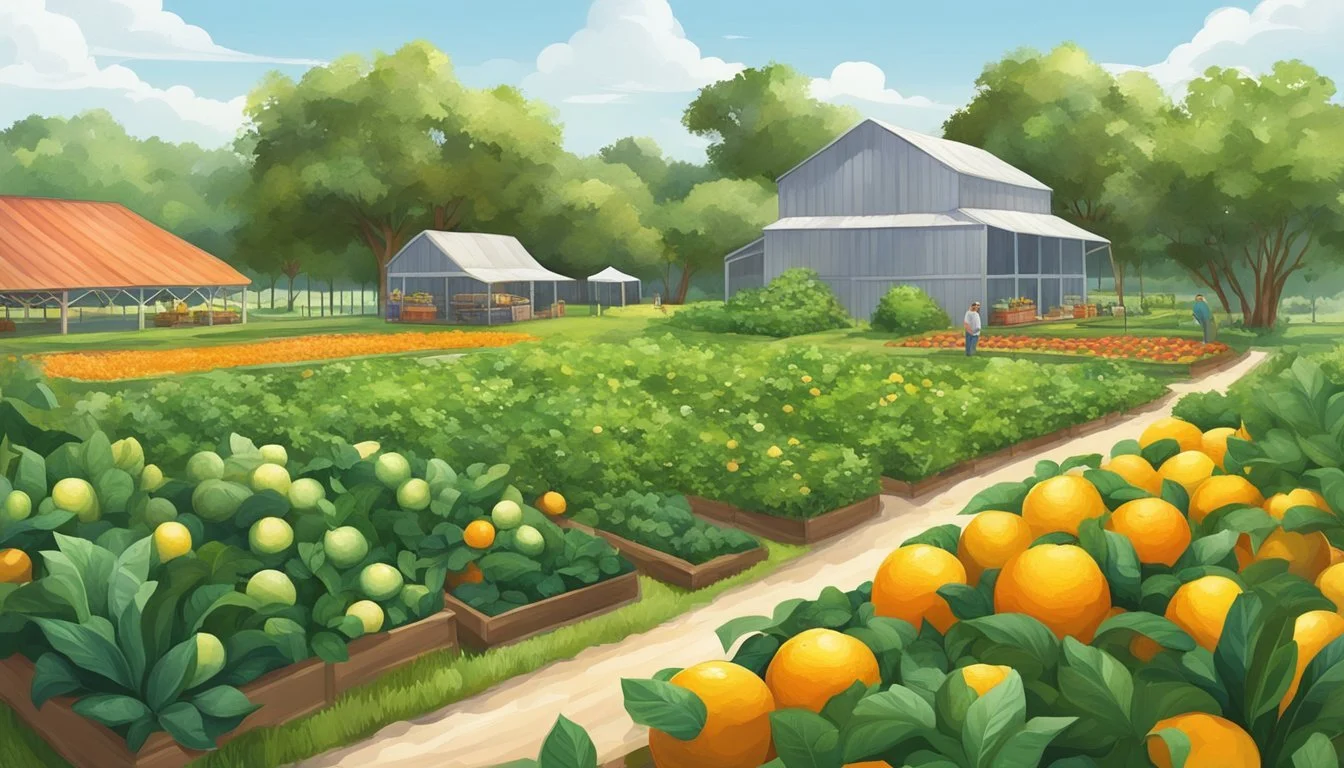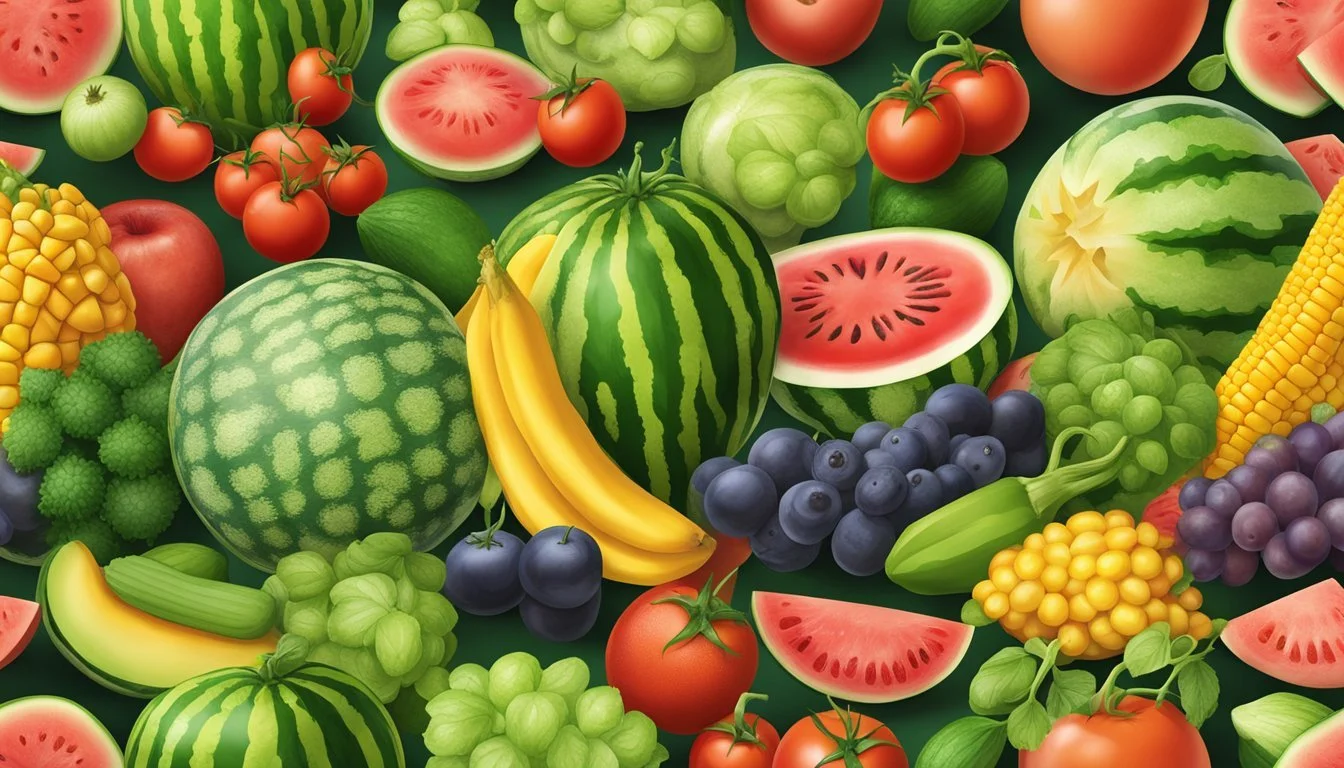Florida Seasonal Fruit & Vegetables in July
Your Guide to Fresh Picks
This Article is Part of our Florida Seasonal Fruit & Veg Calendar
Florida's diverse climate allows for a wide array of fruits and vegetables to thrive. In the heart of summer, the month of July is particularly bountiful. With long, sun-filled days and warm weather, various crops reach their peak, offering residents and visitors alike the opportunity to enjoy fresh, local produce. This not only supports the local economy but also encourages a diet filled with a variety of nutrients and flavors.
Across the state, from the panhandle to the southernmost tip, July's seasonal offerings include fruits such as the juicy muscadine grapes and the luscious mango. These fruits, among others, are not just popular for their taste but are also integral to Florida's agricultural identity. Alongside these, vegetables such as okra, peppers, and sweet corn reach their prime, making them staples in local cuisine.
The abundance and variety of produce available in July is a testament to Florida's rich agricultural resources. Year-round, the state's farmers work diligently to cultivate crops that are adapted to the regional climate, ensuring a constant rotation of fresh produce for markets and tables across the state. Whether incorporated into traditional recipes or enjoyed raw, Florida's fruits and vegetables are a celebration of the state's agricultural abundance.
Climate and Its Influence on Produce
In Florida, the climate exerts a significant impact on the agricultural calendar. The state enjoys a subtropical climate in the north and a tropical climate in the south, allowing for a wide variety of fruits and vegetables to thrive during different seasons. The summer months, particularly July, present a unique growing environment, shaped by the temperature, rainfall, and humidity.
Temperature: July’s heat can affect crop yields and quality. For summer-hardy vegetables like okra and sweet potatoes, the warm climate is beneficial and promotes vigorous growth. However, excessively high temperatures can stress plants, leading to a reduction in produce quality and quantity.
Rainfall: Florida's summers are characterized by frequent rainfall, crucial for crop irrigation. This natural watering process helps maintain soil moisture levels but can also encourage the spread of plant diseases. Farmers must balance the advantages of rain with careful disease management.
Humidity: The high humidity of Florida's summers assists in keeping the soil moist and helps to prevent plant dehydration. However, it can also promote fungal diseases, which farmers must monitor and control to protect their crops.
Below is a table listing some fruits and vegetables that typically thrive in Florida's July climate:
July Produce Ideal Conditions Okra Warm, moist Sweet Potato Warm, well-drained soil Mango Tropical, sunny Avocado (how long does avocado last?) Warm, humid Passion Fruit Warm, sunny
Overall, growers in Florida must adapt to the dynamic climate and the challenges it presents to ensure a successful harvest. They utilize their knowledge of seasonal variations to optimize planting schedules and agricultural practices for the best outcomes.
Key Vegetables Available in July
In July, Florida's vegetable harvest is at its peak, presenting an array of vibrant and fresh picks from local farms. Consumers can enjoy a diverse selection, from nutrient-rich leafy greens to robust nightshades.
Leafy Greens
Consumers find that July offers an abundance of leafy greens in Florida. Local markets typically have fresh kale, spinach, and collard greens (how long do collard greens last?). These greens are known for their versatility and health benefits.
Root Vegetables
Root vegetables thrive in Florida's summer climate. Carrots and beets are readily available, making them ideal for adding a crunchy texture and natural sweetness to meals.
Nightshades
Florida's warm weather is conducive to a fruitful harvest of nightshade vegetables. Shoppers can easily find eggplants (how long does eggplant last?), peppers, and tomatoes in local markets. These vegetables are staples in many dishes for their rich flavors and textures.
Eggplant: Available in various shapes and sizes, perfect for grilling or baking.
Peppers: Including bell peppers in a variety of colors, as well as spicy options like jalapeños.
Tomatoes: Ripe and bursting with flavor, used in salads, sandwiches, and sauces.
Gourds and Squash
Gourds and squash are also in season during July in Florida. Varieties such as zucchini and yellow squash are in abundance. They are commonly used in light summer meals, whether grilled, sautéed, or spiralized.
Each vegetable mentioned offers not only distinct flavors but also a range of health benefits and culinary uses. Residents and visitors alike have the opportunity to enjoy these fresh, seasonal offerings from Florida's local farms and markets.
Seasonal Fruits Harvested in July
During July, Florida's fruit harvest is abundant, offering a diverse selection of fresh flavors ranging from sweet citrus to lush tropical fruits. Consumers can find a variety of fruits at their peak.
Citrus Fruits
In Florida, July is not the peak season for citrus fruits, as most varieties have ended their seasons. However, some late-season grapefruit varieties may still be available, offering a tart and tangy flavor.
Berries
July is typically beyond the traditional berry season in Florida, and one may not find local blueberries, as their season generally wraps up in June.
Stone Fruits
Stone fruits like peaches are coming into their prime in July. These fruits are known for their succulent texture and sweet flavors and are perfect for a range of dishes, from pies to salads.
Tropical and Exotic Fruits
July is the prime time for an array of tropical fruits. Florida's warm climate during this month is ideal for:
Mangoes: With their rich, sweet flavor, mangoes are a favorite for fresh eating, desserts, and sauces.
Avocados: Versatile in use, these creamy fruits are essential for guacamole and also feature in various healthy dishes.
Papaya: This tropical fruit provides a sweet, musky essence and is often eaten fresh or used in smoothies.
Passion Fruit: Known for its aromatic flavor, passion fruit enhances the taste of desserts and drinks.
Florida also sees the harvest of melons, including watermelon, which is a refreshing summer staple due to its hydrating and sweet properties. Exotic fruits such as guava and lychee are also in season, offering unique flavors and nutritional benefits.
Herbs and Other Plants
In July, Florida's gardeners can benefit from the state's warm climate to grow a variety of herbs and other plants that thrive in the summer heat.
Herb Varieties
Florida gardeners have a range of herbs to choose from that can handle the humid and hot conditions of July. Here’s a list of recommended herbs:
Basil: This heat-loving herb can be sown directly into the garden.
Mint: Known for its hardiness, mint is an excellent choice for the Florida summer.
Parsley: Fresh parsley can usually withstand the high temperatures when well-watered.
Rosemary: This robust herb is well-adapted to the heat and is a perennial favorite.
Oregano: Thriving in hot conditions, oregano is perfect for a sunny spot in the garden.
Additional Plants
Beyond herbs, Florida’s July climate also suits several vegetables and other plants. Gardeners can expect success with:
Celery: Prefers a moist, fertile soil and can tolerate semi-shaded areas.
Cucumbers: Plant in a sunny location and keep the soil consistently moist.
Lettuce: Even in heat, some heat-tolerant varieties of lettuce can be grown successfully.
Mushrooms: Can be cultivated in shady areas where temperatures are less intense.
Peanuts: A warm-weather crop that can be planted in July and requires full sun.
Pumpkins: Best planted in late July for a fall harvest; they need space to spread out.
Radishes: Fast growers, radishes can be planted now for a quick harvest.
Spinach: Opt for heat-resistant varieties and provide ample water.
Year-Round Produce Options
In Florida, certain fruits and vegetables are available throughout the entire year, making it convenient for consumers to enjoy fresh produce any month. Among these, cabbage and carrots stand out as particularly versatile vegetables that are consistently available.
Cabbage is a sturdy vegetable that thrives in Florida's varied climate, making it a staple that can be found fresh in markets every month. It can be used in an assortment of dishes, from salads to sautéed sides.
Similarly, carrots are a hardy crop in the state. Known for their adaptability, carrots bring sweetness and crunch to meals, whether raw or cooked. They are also a rich source of beta-carotene, enhancing their appeal as a healthy option.
Collard Greens are another vegetable that gardeners and farmers in Florida grow throughout the year. These nutrient-dense greens are a classic ingredient in Southern cooking and are often prepared as a hearty side dish.
Here is a brief list of some year-round produce options in Florida, highlighting the items mentioned above:
Vegetables:
Cabbage
Collard Greens
Fruits:
Coconuts
These items accessible year-round provide both residents and visitors a taste of Florida's agricultural bounty any time they visit the state.
Local Farming Practices
In Florida, local farmers implement a variety of sustainable practices to cultivate a diverse range of crops under the state's unique climatic conditions. During the month of July, focus shifts toward tropical fruits and leafy greens, which thrive in the warm weather.
Farmers often use crop rotation and integrated pest management (IPM) to maintain soil health and control pests without relying heavily on chemicals. These methods not only preserve the local ecosystem but also yield produce that meets high-quality standards.
Tropical Fruit Cultivation: To grow tropical fruits such as mangos, avocados, and papayas, farmers rely on Florida's humid subtropical climate. They:
Utilize drip irrigation to conserve water and minimize waste.
Practice selective pruning to ensure adequate sunlight exposure and air circulation.
Leafy Greens Production: Leafy greens such as kale, spinach, and various lettuces are also a staple in July. Farmers manage these crops by:
Applying mulch to retain soil moisture and suppress weeds.
Harvesting in the early morning to preserve freshness and nutritional value.
Practices Tropical Fruits Leafy Greens Irrigation Drip Systems Timed Sprinkler Sets Pest Management IPM Strategies Natural Predators Harvest Technique Selective Handpicking Cool Morning Harvests Soil Health Organic Amendments Regular Crop Rotation
These practices contribute to a stable and productive agricultural sector, supplying not only the state but often other regions with fresh, seasonal produce. The dedication to environmentally sound methods ensures that Florida's agricultural heritage remains robust and sustainable.
Shopping and Seasonal Selection
When shopping in Florida during July, consumers have the opportunity to purchase a variety of fresh produce directly from local farmers and markets. The state prides itself on a rich selection of fruits and vegetables that reach peak freshness in the summertime. Shopping for seasonal produce not only supports local agricultural businesses but also ensures that consumers enjoy produce at its most flavorful state.
Fruits available in July typically include:
Mangoes
Avocados
Guava
Vegetables to look for:
Okra
Peppers
Sweet Corn
Florida's Department of Agriculture and Consumer Services advocates for the consumption of "Fresh From Florida" products. They promote the economic benefits of buying locally and the nutritional advantages of consuming fresh produce. By doing so, consumers contribute to the local economy and sustainable agricultural practices within the state.
Farmers' markets and local grocers often highlight these in-season items, making it simple for shoppers to identify and select the freshest produce available.
Here is a simple table to guide consumers on what to look for:
Type Produce Fruit Mango, Avocado, Guava Vegetable Okra, Peppers, Sweet Corn
When selecting produce, one should look for vibrant colors and firm textures, indicators of freshness and ripeness. Sourcing fruits and vegetables during their peak season ensures the best in flavor and nutrient content, aligning with Florida's initiative to promote healthy eating habits and local agriculture.
Understanding the Florida Growing Season
Florida's growing season is influenced by its subtropical climate, marked by a significant variation across its regions. The Florida Department of Agriculture recognizes the state's unique agricultural zones, which dictate the optimal planting periods for produce. Spring and fall provide mild temperatures that support a wide range of fruits and vegetables, while the winter months, although generally mild, can vary and impact planting schedules.
The state is subdivided into three primary climate zones:
North Florida, with a shorter growing season due to cooler temperatures
Central Florida, balancing between the extremes of north and south
South Florida, where the warm climate allows for an extended growing season
Each zone has its specific planting times, which can be found on resources such as the University of Florida's gardening guides.
For instance, in July, gardeners can benefit from planting:
Vegetable Planting Time Okra Spring to fall Southern peas Spring to fall Sweet potatoes March to June
Fruit planting is also dictated by the region and seasonal temperatures. It is crucial to stay informed of the shifts in weather patterns, as these can affect the traditional schedules, causing early or late frosts or unseasonal heat waves. Farmers and gardeners are advised to monitor local forecasts and consult with the Florida Department of Agriculture for the most current and relevant information.
Conclusion
In the state of Florida, July is a time when a variety of produce reaches its peak freshness, benefiting immensely from the region's unique climate. Florida's warm temperatures and ample sunshine create ideal growing conditions for an assortment of fruits and vegetables during this month.
Seasonal Produce in July
Fruits:
Watermelon
Vegetables:
Collard greens
Chiles
The availability of such produce is not only backed by local agricultural data, but also reinforced by its presence in Florida's markets and grocery stores. Consumers are encouraged to take advantage of the season and enjoy these fresh options, as they are at their best in taste and nutritional value.
Florida's agriculture notably contributes to its economy and local food movements, with many restaurants showcasing "Fresh from Florida" items on their menus. The emphasis on locally-sourced ingredients supports sustainability and provides diners with the freshest possible options.
When shopping for produce this July, shoppers in Florida should look for signs marking fruits and vegetables as in-season. This distinction not only guarantees freshness but also promotes a sustainable and health-conscious lifestyle integral to Florida's culinary scene.







